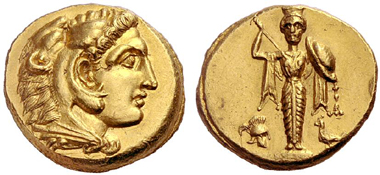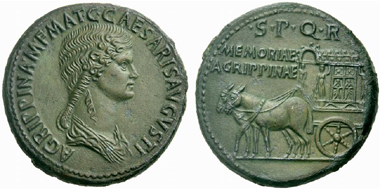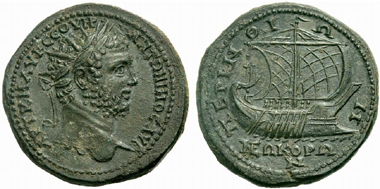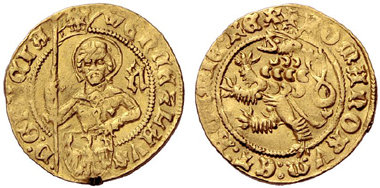23-06-2010 – 01-01-1970
Auction 149 – Numismatic Rarities
Buyers love quality
On June 24th, 2010, shortly before the summer break, auction 149 of the auction house Numismatik Lanz in Munich was held. The catalogue comprised a potpourri of ancient, medieval and modern coins including rarities and showpieces of finest preservation.
172 Pergamon (Mysia). Herakles, Son of Alexanders the Great, d. 309(?). Gold stater, prior to 309. Extremely fine specimen. Estimate: 40,000 Euros. Price realized: 46,000 Euros.
The most expensive ancient coin was a gold stater from Pergamon. The extremely fine specimen had been estimated at 40,000 Euros and sold for 46,000 Euros. The historically highly significant coin was a piece presumably of Herakles, illegitimate son of Alexander, who grew up in Pergamon. It is very likely that he commissioned the emission before his assassination in 309.
Apart from that, everything deviating from the ordinary was expensive. Be it an archaic stater from Thasos depicting a satyr raping a nymph (no. 82 / 1,200 / 2,700 Euros), be it a tetradrachm from Acanthus with a lion slaying a bull (no. 92 / 3,000 / 5,000 Euros) or a tetradrachm from Athens of finest style (no. 155 / 4,000 / 6,000 Euros).
Buyers appreciated rarities, too, especially when it came to fractions. A “just” very fine hemiobol from the island of Pordosilene brought 900 Euros on its pre-sale estimate of 200 (no. 184).
The favorites of collectors of ancient coins continue to be the pieces from the Roman Republic – and auction 149 had plenty to offer there. The 43 pieces that were for the most part quite attractive were estimated at 24,100 Euros whereas the end result read 28,650 Euros – despite Lanz calling at 60%. Only a single lot was returned. To mention but two examples: a not too rare but extremely fine denarius of Marcus Aurelius Cotta from 139 with Herakles in a centaur biga on its reverse reached 650 Euros on its estimate of 300 Euros (no. 292), and an extremely fine denarius of Cn. Pompeius Magnus from 46-45 from Spain (Cr. 469/1a) brought 1,300 Euros (no. 319 / 500 Euros).
347 Agrippina Maior. Sestertius. RIC 55. Extremely fine. Estimate: 2,500 Euros. Price realized: 8,500 Euros.
One focus of auction 149 was Roman imperial coins. Impressive sums were reached especially by the ladies and the barracks emperors. Hence, an extremely fine sestertius of Agrippina Maior with a mule-drawn carpentum that was minted under Claudius reached 8,500 Euros (no. 347 / 2,500 Euros), and a very fine dupondius of Agrippina Minor from Thrace sold for 4,400 Euros (no. 352 / 2,000 Euros). The buyer of a bronze medallion of Commodus showing the dioscuri on its reverse was pretty lucky: the rare and about extremely fine piece with its price of 8,500 Euros remained below its estimate (no. 422 / 10,000 Euros).
455 Perinthos (Thrace). Caracalla. Bronze medallion. Rev. battle ship. Very rare. Estimate: 4,000 Euros. Price realized: 21,000 Euros.
In contrast, some extremely fine provincial bronzes considerably exceeded their estimates. With a splendid bronze medallion of Caracalla from the Thracian city of Perinthos therefore the gavel was going down at incredible 21,000 Euros (no. 455 / 4,000 Euros) whereas a bronze from Antiochia on the Maeander in Caria, minted under Gallienus, with a depiction of a stylized bridge, brought 2,600 Euros (no. 518 / 900 Euros).
Some rare pieces of the barracks emperors with magnificent portraits should not be omitted. To give one example: for a brilliant uncirculated denarius of Gordianus I Africanus a collector willingly paid 6,250 Euros (no. 486 / 3,500 Euros).
609 Holy Roman Empire. Wenceslas IV of Bohemia (1378-1419), Auerbach. Gold gulden. Extremely rare. About extremely fine. Estimate: 10,000 Euros. Price realized: 38,000 Euros.
Let us move from antiquity to the modern times. Although the ancient coins stand alone in their impressive results, it nevertheless became clear that the market is healthy. Only few pieces were left unsold; the major part of the material reached results matching their pre-sale estimates. There were three aberrations that of course should not go unnoticed. An extremely rare and about extremely fine gold gulden of Wenceslas IV (1378-1419) from Auerbach exceeded its estimate of 10,000 Euros when it was sold for 38,000 Euros (no. 609) – by that, it became the auction’s second most expensive piece.
A denarius of Henry IV from Dortmund, extremely fine and with a particularly fine half-length portrait of the ruler, brought 3,250 Euros (no. 606 / 800 Euros); an extremely fine penny of the English king Edward the Confessor, likewise especially clearly minted, was sold for 650 Euros (no. 726 / 250 Euros).
Please find the complete list of results on the internet at http://www.sixbid.com/nav.php?p=pr&sid=258. At http://www.sixbid.com/nav.php?p=viewsale&sid=258&s=b all lots including estimate, price realized, image and description can be viewed.







